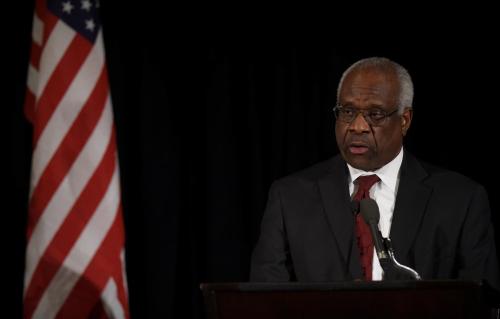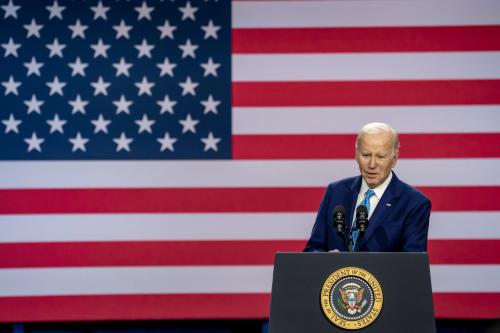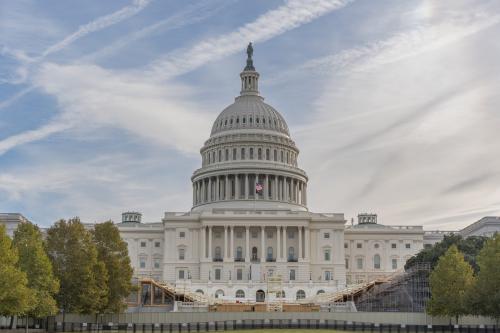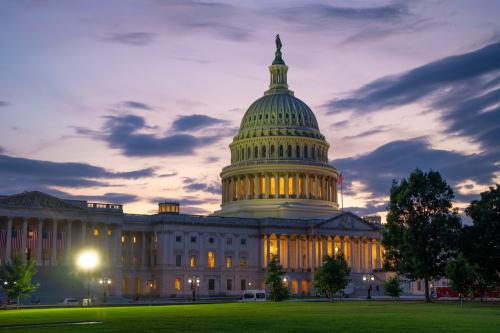House Democrats turned heads on Capitol Hill last week when news surfaced of their proposed procedural gambit to raise the federal government’s debt limit. Relying on the century-old House discharge rule, minority party Democrats aim to force a vote on a measure to lift the debt ceiling. The discharge rule, however, is ill-suited for swift, surgical strikes, and Democrats will struggle to secure the necessary support of a handful of Republicans. While nothing can be ruled out, the discharge rule is unlikely to resolve today’s impasse.
Here’s how the rule works
The discharge rule dates from the 1910 revolt against House Speaker Joseph Cannon (R-IL). Frustrated by Czar Cannon’s tight-fisted control of the House, Democrats and Progressive Republicans fought for a rule that would allow a majority to bring bills to the floor that were bottled up in committee, circumventing committee and party leaders. The House has tweaked the rule a few times, but its purpose remains unchanged: If a majority can meet the rule’s strict requirements, it can force a vote to discharge a measure that might otherwise not see the light of day.
Sand traps complicate discharge efforts. A lawmaker first introduces a favored bill, which is then referred to one or more committees. After a bill has been in committee for thirty legislative days, a lawmaker can file a discharge motion (known as a “discharge petition”), which requires signatures of 218 lawmakers (a majority of the 435-member House) to advance. Legislators can also target discharge petitions at special rules (after they have been pending in the Rules Committee for seven legislative days) resolutions that stipulate the terms of debate for major bills. Any petition securing 218 signatures takes a spot on the House discharge calendar.
But wait. There’s more! Discharge motions must then sit on the calendar for at least seven legislative days before a signatory can notify the House that they intend to offer the discharge motion on the floor. The Speaker then designates the time for consideration of the discharge motion within two legislative days after the legislator announces their intention (except near the very end of the congressional session when rules prohibit discharge motions). A majority vote discharges the targeted matter, whether a bill or a special rule that stipulates how the chamber will consider that bill.
Petitions rarely succeed
History offers few glimmers of hope for Democrats.

As shown in the above figure, lawmakers have successfully discharged less than four percent of the 639 discharge petitions introduced since 1935. That number is perhaps deceptively low. A credible threat of discharge can convince committee or party leaders to bring to the floor their own version of the bill or special rule targeted by a petition. Viewed that way, the House has passed about eight percent of targeted measures.
House passage of course isn’t enough to become law. And discharge motions in the Senate can be filibustered. Indeed, according to the Congressional Research Service, Congress and the president have enacted only a few measures targeted for discharge: the nation’s first minimum wage law in 1938, a 1959 federal pay law, campaign finance reform in 2002, and renewal of the Export-Import Bank in 2015. True, Ross Perot in 1993 also successfully spearheaded a drive to reform the discharge rule — propelled by a discharge motion. But the historical record is clear: Discharge efforts rarely succeed.
Barriers to success
Both procedural and political barriers complicate the effectiveness of the rule.
First, the rule’s several layover periods and the challenge of securing 218 signatures make the discharge motion ill-suited for acting swiftly in an emergency — whether lifting the debt ceiling or passing a stopgap spending bill to prevent a government shutdown.
This year, Democrats planned ahead: A junior Democrat quietly introduced a decoy debt limit bill this past January to get the discharge clock ticking. But Democrats may still run out of time before the government hits the default date. Even if every Democrat and five GOP members sign the petition quickly, the Bipartisan Policy Center calculates that the earliest the House could vote to discharge a special rule to advance the decoy bill would be June 7. The treasury expects to run out of cash as early as June 1.
Second, as political scientists demonstrate, majority party lawmakers in recent decades are typically reluctant to sign discharge petitions. That’s because lawmakers’ policy priorities often take a back seat to demands they be partisan team players. Signing a petition in today’s House — let alone teaming up with the minority to vote for it on the floor — would signal an attack on the majority party. That’s probably especially so in an era of exceedingly small majorities.
Third, the likeliest GOP signers probably hail from amongst the 18 members who represent swing districts — including Republican members of the bipartisan Problem Solvers Caucus. Representing more competitive districts might encourage them to support Democrats’ effort to prevent a default. But those swing district GOP members might if anything be more loyal and reliable team players for the GOP leadership than far-right colleagues — probably to fend off primary challenges from the right. What’s more, all swing-district GOP members voted last week for the deal negotiated by GOP leaders to trim spending and raise the debt limit. That likely limits their interest in crossing GOP party leaders to sign the Democrats’ petition.
Still, a slim GOP majority, uncertainty about the path ahead, and the high stakes of a government default mean no potential solution can be summarily dismissed.
The Brookings Institution is committed to quality, independence, and impact.
We are supported by a diverse array of funders. In line with our values and policies, each Brookings publication represents the sole views of its author(s).







Commentary
Don’t count on the House discharge rule to raise the debt limit
May 9, 2023